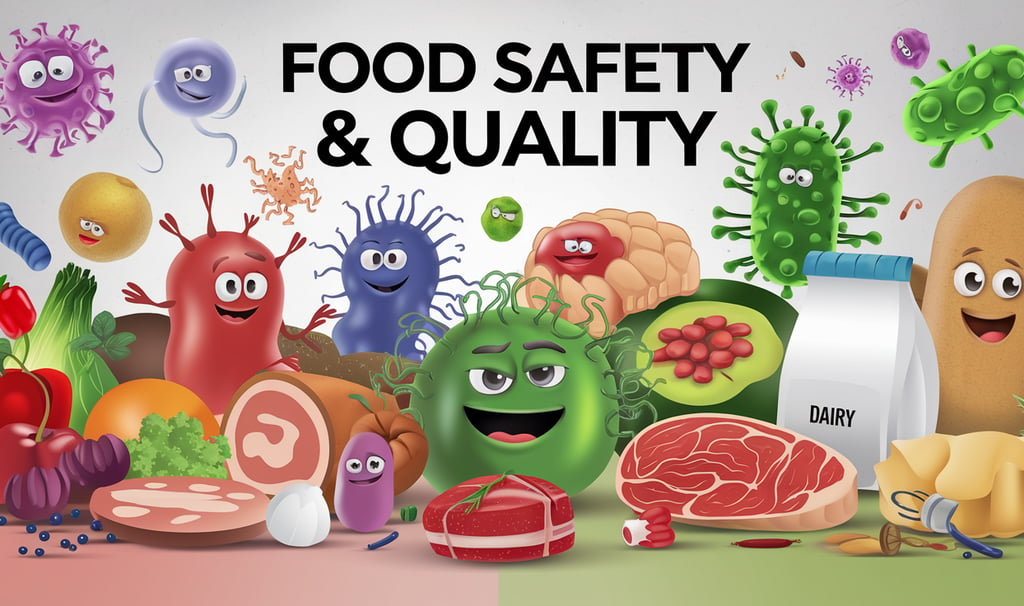The Importance of Food Safety and Quality: A Guide for Every Consumer
Food is an essential part of our daily lives. It nourishes us, brings people together, and reflects culture and tradition. However, ensuring that the food we eat is safe and of high quality is just as important as enjoying its taste. Contaminated or low-quality food can lead to serious health risks, economic losses, and a lack of consumer trust. This article serves as an introduction to food safety and quality, emphasizing the importance of proper food handling, storage, and regulatory standards. Whether you're a home cook, a food industry professional, or simply someone who wants to ensure your family eats safe, high-quality food, understanding these principles is crucial. From flowy skirts and breezy blouses to statement accessories and comfy boho flats, let’s dive into the ultimate boho wardrobe essentials for summer!
3/14/20252 min read


What is Food Safety?
Food safety refers to the handling, preparation, and storage of food in ways that prevent contamination and foodborne illnesses. This involves measures such as:
Proper hygiene for food handlers (washing hands, using gloves, etc.)
Correct food storage to prevent spoilage and bacterial growth
Cooking food at safe temperatures
Preventing cross-contamination between raw and cooked foods
The World Health Organization (WHO) estimates that unsafe food causes around 600 million cases of foodborne illnesses each year, making it a global public health issue. Understanding and applying food safety measures can help reduce these risks.
What is Food Quality?
Food quality is a broader term that includes safety but also encompasses other attributes such as taste, texture, appearance, nutritional value, and freshness. High-quality food is not only safe to consume but also meets the expectations of consumers regarding its flavor and nutritional benefits.
Factors that affect food quality include:
Freshness – How recently the food was harvested, prepared, or packaged
Nutritional value – The levels of vitamins, minerals, and other nutrients present
Processing methods – The techniques used to prepare and preserve food
Packaging – How food is stored and protected to maintain its quality
The Relationship Between Food Safety and Quality
While food safety focuses on preventing illness, food quality ensures that food meets consumer expectations. The two go hand in hand. A product can be of high quality in terms of taste but still be unsafe if not handled correctly. For example, fresh seafood may look great and taste delicious, but if not stored at the right temperature, it can harbor harmful bacteria.
Regulatory agencies worldwide, such as the U.S. Food and Drug Administration (FDA) and the European Food Safety Authority (EFSA), have established guidelines to ensure that food safety and quality standards are met. These regulations help protect consumers and maintain public health.
Key Principles of Food Safety and Quality
To maintain food safety and quality, consider these key principles:
Hygiene and Sanitation
Always wash hands before handling food
Clean kitchen surfaces and utensils regularly
Store food in clean, sealed containers
Proper Storage and Temperature Control
Refrigerate perishable foods promptly (below 40°F/4°C)
Freeze food to extend shelf life
Avoid leaving food at room temperature for extended periods
Cooking and Preparation
Cook meat, poultry, and seafood to the recommended temperatures
Use separate cutting boards for raw meats and vegetables
Avoid using expired ingredients
Understanding Food Labels
Check expiration dates before purchasing
Look for certifications such as organic, non-GMO, or food safety seals
Read ingredient lists to avoid allergens or additives
Preventing Food Waste
Plan meals to reduce over-purchasing
Store leftovers properly and consume them within safe timeframes
Understand the difference between “Best By” and “Use By” labels
Why Food Safety and Quality Matter
Ensuring food safety and quality has significant benefits:
Health Benefits – Reduces the risk of foodborne illnesses
Economic Impact – Prevents financial losses from food recalls or wastage
Consumer Confidence – Builds trust in food brands and businesses
Sustainability – Encourages responsible food production and consumption
Food safety and quality are crucial for maintaining public health and ensuring that consumers receive nutritious, safe, and satisfying meals. Whether you're preparing food at home or purchasing from a restaurant or store, being informed about best practices can help you make better choices.
As this blog grows, we will explore food safety tips, quality control measures, industry regulations, and expert advice to help everyone—from consumers to professionals—navigate the world of food safety and quality. Stay tuned for more insights, and feel free to ask any questions related to food safety.
What are your biggest concerns when it comes to food safety and quality?
Share your thoughts in the comments, and let’s start a conversation!
Join us on Pinterest
letstalk@lorybs.com
© 2025. All rights reserved.
